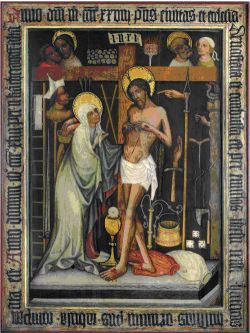The National Gallery in Prague –Collection of Old Masters
31.08.2006 / 14:45 | Aktualizováno: 05.04.2011 / 18:16
(This article expired 14.09.2010 / 02:00.)
There are not many historical regions in Central Europe which can pride themselves on having the same wealth and variety of cultural tradition as Silesia has. The exhibition “Silesia – a Pearl in the Bohemian Crown”, co-organized by the National Gallery in Prague, the Museum of Copper in Legnica and the Institute of Art History of Wrocław University, reveals and recollects the significance of artistic relations between Silesia and Bohemia as concerns the development of fine arts in the high Midd
The National Gallery in Prague -

Collection of Old Masters
Silesia - a Pearl in the Bohemian Crown
Three Periods of Flourishing Artistic Relations
I. The Golden Age of Luxemburg Rule
II. The Glamour of Rudolfine Prague
III. The Baroque Flamboyance of Monasteries and Palaces
Prague, Wallenstein Riding School Gallery
17 November 2006 - 8 April 2007
Open daily except Mondays, 10 a.m. - 6 p.m.
Entrance fee: basic - 100 CZK, reduced - 50 CZK, families -
150 CZK
The exhibition is held under the auspices of Evžen Tošenovský,
District Administrator of the Moravian-Silesian District,
and with the moral support of Přemysl Sobotka, Chairmain of
the Senate of the Parliament of the Czech Republic.
The project has been funded by the Ministry of Culture of the Czech Republic and the European Union under the aegis of the CULTURE 2000 program. The works on the project were carried out within the scientific and research plan of the Ministry of Culture of the Czech Republic (project no. 0002328101).
Valdštejnská Street 3, Prague 1
Public transportation: metro line A, tram 12, 18, 20, 22, 23
(station Malostranská)
www. ngprague.cz
There are not many historical regions in Central Europe which can pride themselves on having the same wealth and variety of cultural tradition as Silesia has. The exhibition "Silesia - a Pearl in the Bohemian Crown", co-organized by the National Gallery in Prague, the Museum of Copper in Legnica and the Institute of Art History of Wrocław University, reveals and recollects the significance of artistic relations between Silesia and Bohemia as concerns the development of fine arts in the high Middle Ages and early modern era. This exhibition focuses on major works from the fields of painting, sculpture and arts and crafts, many of which are being exhibited for the first time.
The first part of the exhibition - The Golden Age of Luxemburg Rule - is devoted to the flourishing development of the Gothic style under the reign of the Luxemburg dynasty. Apart from works by artists of Bohemian origin, who left their key works in Silesia, this section also presents the foundation activities of bishops and donations of Bohemian art to Silesian monasteries and convents. From amongst the ultimate expressions of Gothic sculpture, visitors will probably be most attracted to the so-called Madonnas seated on a lion, which are characteristic for the Silesian region. According to some interpretations, their symbolism is linked to the intellectual environment at the court of Emperor Charles IV.
The second part of the exhibition - The Glamour of Rudolfine Prague - presents the artistic contact between Prague and Wrocław in the 16th and 17th centuries. Art in Silesia was strongly influenced by the oeuvre of Mannerist artists concentrated around the Prague court of Rudolf II. Apart from these works, the exhibits here include relics that remind us of the complex religious history of Silesia, as well as historical maps and vedute of Silesian cities. This section, moreover, illustrates the irreplaceable role of the humanist-educated middle classes and nobility, whose representatives were also present in Prague during the late Renaissance.
The last chapter - The Baroque Flamboyance of Monasteries and Palaces - focuses on Silesian Baroque art from the end of the Thirty Years' War to the Prussian annexation of the country. The dominant exhibits of this section are the monumental canvases created by painters of Silesian origin who were active for Bohemian founders (M. Willmann, J. K. Liška) as well as Bohemian artists inspired by Silesian works (P. Brandl, V. V. Reiner). A key role during the high Baroque period was played by Silesian sculpture which, in a characteristic way, developed from the lineage of M. B. Braun and his students. Viewers will be also introduced to works displaying the Silesian influence on the arts of contemporary Bohemia and especially on productions linked to Bohemian monasteries and convents.
The aim of the event is not only to introduce the Czech and Polish but also the European and global public to our shared cultural heritage; a heritage that has been, until recently and to a certain extent, omitted or one-sidedly misinterpreted for historical and political reasons.




